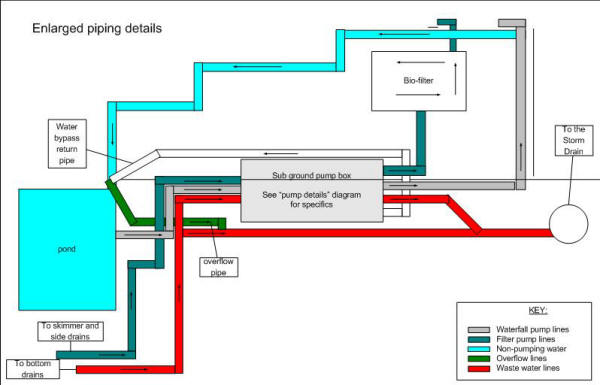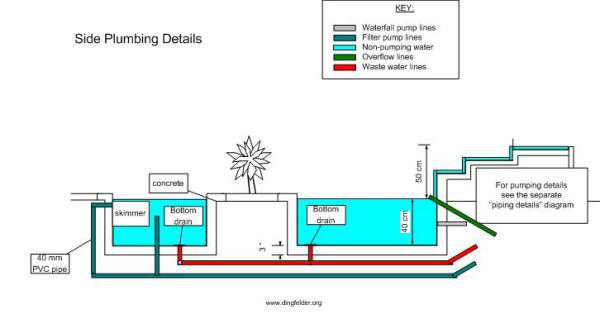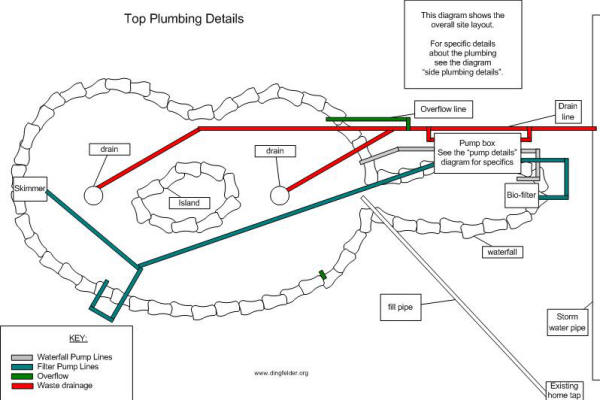 |
Aquatic Gardens
Ponds, Streams, Waterfalls
& Fountains:
Volume 1. Design & Construction
Volume 2. Maintenance, Stocking, Examples
V. 1
Print and
eBook on Amazon
V. 2
Print and
eBook on Amazon
by Robert (Bob) Fenner |
 |
| Re: updated pond diagrams Hi again bob, <Andy> I
hope you are having a good day... <Thus far... I haven't
woken up!> I revised my diagrams this morning and thought I
should get you to take another look: http://www.dingfelder.org/photos/public/pond.htm
<Got them!> In this new version, I put the pumps into a pump
box and added details for where shutoff valves should go
etc. I am not 100% sure if I have the backflow
preventers in the right place but I am getting close.
<Schematically this looks good, complete> The other thing I
did after researching how some Koi ponds have been built is to
split the waste line into 2 branches... <Ah, yes> one line
goes from the bottom drain directly to the waste line, the other
one can be directed through the waterfall pump if needed.
<Sometimes a good idea... AFTER initially venting what water is
there of course> The situation I have is that the bottom drains
are lower than the waste line, so if I use the normal (un-pumped)
waste purging, <Yes, I understand this... saw your conversation
with Trigger-happy on WWF... his comment for a drain
"box" is a good one... but can't be done practically
due to this fact> the level of the pool can not (via gravity)
empty the entire pool, it will only empty it up to the level of the
waste line. IMHO this is good because it prevents me
from un-intentionally emptying the entire pond, but it is bad
because I can NOT empty the entire pond, if I need to for some
reason. <I understand... but you could pump it...> That's
why I forked off a line (which is usually closed
off) from the bottom drains, that goes to the waterfall
pump. So, if I ever really need to empty the whole
thing, I can flip the waste line switch, and flip the output lines
from the pump to go to waste instead of the waterfall, and can then
empty it all. <Yes... am starting to wake up> Also, would you
make the sub-ground pump housing out of a plastic container?
<Mmm, no... almost certainly either out of pre-formed concrete
(is this what you've settled on for the basin construction?) or
block on a good foundation on a type II... water proof
coated...> I was thinking of doing it out of brick and having
the input lines permanently cemented in, then having flexible lines
screw into them, and these lines can connect to the
pumps. In that way I could more easily remove the pumps.
<I would not use flexible... some annealing with solid issues...
but DO use true-union couplers for this purpose... secure the
intake and discharges from your volutes with cut schedule 80
nipples and a bit of silicone sealant...> What do you think,
does that make sense? Cheers, Andy <Thus far... a
bunch more that could be discussed, perhaps will. If/when in doubt,
get out and start digging! REALLY... and consider building next,
the filter vault... that will likely be part of the (next)
waterfall apex, trough... You'll see. BobF> |
 |
 |
 |
 |
 |
Amusing pond info Bob, <Andy> I thought you might be
amused by this email I got from a supplier in Australia. I
asked them for advice on what pumps etc I need. They responded with
what they felt was "appropriate" equipment Note:
I have estimated that my pond will be somewhere around 6000 liters in
volume, which means I should pump 3000 l of water per hour (if I'm
calculating it right). <This is... about right... if it
were not too expensive, doubling or even trebling this might be
better... depending on your livestock (if plants only... it can
trickle... if lots of Koi, kick up the volume), but your filter
volume/surface area needs to be considered, possibly partially bypassed
if there is too much flow... to accommodate your falls...> The
waterfall head will be about 3, and assuming the worst case,
of a 24" wide waterfall at 3/8" thick, I assume I would need
something like 9000 lph. <Yes, once again,
possibly more aesthetically> So a 12000 lph flow should be enough
right? <Yes> and with a smaller (12"
wide) waterfall, that could be more like 7000 lph. <Okay> They
are promoting a 32,000 LPH pump below... :-) <And likely with
tremendous head/pressure to boot! I suspect they have stock in the
local utility/electrical supply! Bob Fenner> Cheers, Andy
__________________________________ Thank you for your enquiry. Your
pond will certainly be an attractive feature when it is completed. We
would like to suggest that you do not concrete the pond at all, but use
Xavan pond liner on a sand base as the waterproof membrane. This will
not be subject to cracking and is not affected by soil movement, the
pond liners are especially designed for this application and are
chemically inert. We have calculated from your data that you need a
pump of 10,500 LPH capacity to circulate and filter the pond water.
Your proposed waterfall needs a pump capacity of 32,000 LPH.
To achieve good filtration you should consider the OASE Dual Aquamax
8000 pump, this pump has two inlets and should be installed into the
bottom of the pond as the Aquamax is designed as a filter pump which
draws water from 360° and allows solids up to 10mm dia to be
pumped into the filter. The second inlet can be fitted with a skimmer
if needed. Ideally in your pond the main pump and 2nd inlet should be
placed 1/3 of the pond apart with the filter return at the other 1/3
position, this will give good circulation of water. The filtration
system should run 24/7. <I do agree with the time frame of
operation> The waterfall needs 32,000 LPH and if you want one pump
you could run a Messner M40000 pump which has an output of 38,700 LPH.
8000 LPH can be diverted to run the filtration system and the remaining
30,000 LPH run over the waterfall with a diversion valve to bypass the
waterfall water to the pond when the waterfall is not wanted. <Good
point> We suggest the Blagdon Cyclone 20000 UV-C pressure filter as
the most suitable for your application. <Mmm, not for a biological
pond> The following prices are in Australian Dollars ex our
showroom, but will give a good indication of pricing. Blagdon Cyclone
20000 UV-C $779.00 OASE Aquamax Dual
8000 $799.00 Messner M40000 $2,349.00
(this pump is not on our web site as yet, it is about to be. German
made) OASE skimmer $125.00 Hope that this is of
assistance, have a look and let us know what you think. <Nice gear,
but not for your application. Bob F>
Re: pond advice. Plumbing, waste lines Hey Bob, I posted this on the
forums but thought you might be curious to see it as well. Have a good weekend !
Andy ________________________________________ ok, I had a brainstorming session
with a neighbor, and it seems that if I get a permit (and IF the city allows it)
I may be able to plumb the waste line into the sewer instead of the storm drain.
<Mmm, I wouldn't involve the city, permits if you can avoid them, using the
sewer line... If possible, practical, I dump my waste water on the landscaped
(it's dry here)> If I am allowed to do that, it opens up new possibilities,
because the level is way lower (1 meter?) so it would be lower than my bottom
drains. <As you and I have hinted around, being able to pump the water down is
just about as valuable... a trade off in safety vs. turning a few valves instead
of lifting riser pipes> IF I can use this approach, is there ANY need to have a
pump connected to the waste line? I assume no. <No> The only negative to this
approach that I can think of is that if I flip the drain, the whole pond will
empty... bad if I do not intend on it. <Yes> If I am willing to lose water
during purging (since I am not using a vortex etc) I think it would make sense
to just plumb straight from the bottom drains to the waste line. (note: I do not
pay for water :) ) <... well, could do...> While I was modifying the diagrams to
have this new update, I made a big change to the pumping method... I went to a
single pump, which flows to both the filter and the waterfall, then has ball
valves to control how much flow goes to each, so most of the flow can go to the
waterfall <A definite plus... however, it is "nice" to have an alternate pump
for the chance of the other going out. Bob Fenner>
 |
Aquatic Gardens
Ponds, Streams, Waterfalls & Fountains:
Volume 1. Design & Construction
Volume 2. Maintenance, Stocking, Examples
V. 1
Print and
eBook on Amazon
V. 2
Print and
eBook on Amazon
by Robert (Bob) Fenner |
 |
|
|

